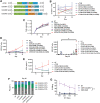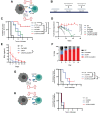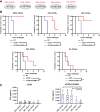A Costimulatory CAR Improves TCR-based Cancer Immunotherapy
- PMID: 35176142
- PMCID: PMC8978620
- DOI: 10.1158/2326-6066.CIR-21-0307
A Costimulatory CAR Improves TCR-based Cancer Immunotherapy
Abstract
T-cell receptors (TCR) recognize intracellular and extracellular cancer antigens, allowing T cells to target many tumor antigens. To sustain proliferation and persistence, T cells require not only signaling through the TCR (signal 1), but also costimulatory (signal 2) and cytokine (signal 3) signaling. Because most cancer cells lack costimulatory molecules, TCR engagement at the tumor site results in incomplete T-cell activation and transient antitumor effects. To overcome this lack of signal 2, we genetically modified tumor-specific T cells with a costimulatory chimeric antigen receptor (CoCAR). Like classical CARs, CoCARs combine the antigen-binding domain of an antibody with costimulatory endodomains to trigger T-cell proliferation, but CoCARs lack the cytotoxic CD3ζ chain to avoid toxicity to normal tissues. We first tested a CD19-targeting CoCAR in combination with an HLA-A*02:01-restricted, survivin-specific transgenic TCR (sTCR) in serial cocultures with leukemia cells coexpressing the cognate peptide-HLA complex (signal 1) and CD19 (signal 2). The CoCAR enabled sTCR+ T cells to kill tumors over a median of four additional tumor challenges. CoCAR activity depended on CD19 but was maintained in tumors with heterogeneous CD19 expression. In a murine tumor model, sTCR+CoCAR+ T cells improved tumor control and prolonged survival compared with sTCR+ T cells. We further evaluated the CoCAR in Epstein-Barr virus-specific T cells (EBVST). CoCAR-expressing EBVSTs expanded more rapidly than nontransduced EBVSTs and delayed tumor progression in an EBV+ murine lymphoma model. Overall, we demonstrated that the CoCAR can increase the activity of T cells expressing both native and transgenic TCRs and enhance antitumor responses.
©2022 The Authors; Published by the American Association for Cancer Research.
Figures






References
-
- Haque T, Wilkie GM, Jones MM, Higgins CD, Urquhart G, Wingate P, et al. Allogeneic cytotoxic T-cell therapy for EBV-positive posttransplantation lymphoproliferative disease: results of a phase 2 multicenter clinical trial. Blood 2007;110:1123–31. - PubMed
-
- Dafni U, Michielin O, Lluesma SM, Tsourti Z, Polydoropoulou V, Karlis D, et al. Efficacy of adoptive therapy with tumor-infiltrating lymphocytes and recombinant interleukin-2 in advanced cutaneous melanoma: a systematic review and meta-analysis. Ann Oncol 2019;30:1902–13. - PubMed
Publication types
MeSH terms
Substances
Grants and funding
LinkOut - more resources
Full Text Sources
Other Literature Sources
Medical
Research Materials

